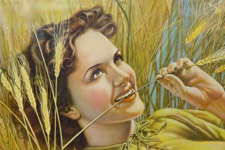 And now – taking a break from our swim in the pool of listmania – we return to our regularly scheduled conversation about what makes the beer we drink different.
And now – taking a break from our swim in the pool of listmania – we return to our regularly scheduled conversation about what makes the beer we drink different.
So time for Barley Part II (you knew I had another old image I was itching to show you).
In his Great Beers of Belgium, Michael Jackson writes about how Brother Thomas – then the brewing director at Westmalle – favored malts from Beatrice-Gatinais in France because of their softness, but the varieties he chose each year varied. That would indicate he was more concerned with quality than consistency, but that is another conversation. The point would be that he recognized that not all two-row pilsner malt is created equal.
Jackson describes how important this was to Brother Thomas: “In discussing a malt from elsewhere, widely used by other brewers, I asked whether he thought it was perhaps a trifle harsh. ‘It’s brutal!’ he replied, thumping the table.”
Brother Thomas may have been a little harsh himself, but the fact is that two different varieties of barley – let’s say Optic and Scarlett – kilned to the same color and then used precisely the same way in a recipe may produce beers that taste noticeably different. One might showcase hop bitterness, another a richer malt character. One isn’t necessarily better (or the other “brutal”) but they are different.
Weyermann Malting® in Bavaria proved this to a panel of industry members, including many brewers, a few years ago. Weyermann brewed four pilsners on its pilot system, each with malt produced from a different barley, and in a blind tasting the panelists had no trouble telling them apart.
As a result, some breweries have since begun ordering pilsner malt made from a specific barley. This isn’t necessarily realistic for your average small brewery and certainly not for the local brewpub you should be stopping by tonight.
So maybe I don’t have a point, but it seems like information you should have.
Barley Part I (in cased you missed it).